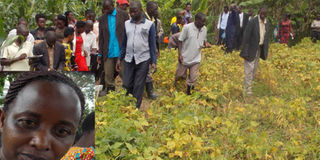Prime
Iron-rich beans are Nakimuli’s gold

Farmers inspect Nakimuli’s model garden. Nakimuli (R) is a model bean farmer in Rakai. Inset is Nakimuli. Photo by Michael J Ssali.
Nearly a hundred farmers from the parishes of Kibona and Katuntu in Rakai Town Council gathered at Winnie Nakimuli’s beans garden located near the district’s headquarters on December 18 2019 to learn about the best agronomical practices in bean production.
It was a farmers’ field day and the function attracted agricultural services extension officers, representatives from community-based organisations and officials from Partnership for Seed Technology Transfer in Africa (Pastta).
Charles Katabalwa, the programme manager of Community Enterprises Development Organisation (Cedo), which also distributes quality bio-fortified beans and sweet potato vines in Masaka sub-region, said that adhering to the best agronomical practices lead to successful yields.
Nakimuli, whose garden is approximately an acre, on top of using the recommended spacing guidelines, applied the fertiliser correctly.
These biofortified beans were planted on October 10 and were ready for harvesting on December 18.
Medi Kanyike, the district agricultural officer, told the farmers that Nakimuli’s garden was proof that growing beans can be profitable business.
Kanyike explained that by planting one kilogramme of beans which costs about Shs3,000, a farmer can earn profit of about Shs20,000. He added that it is often more paying if the farmer does not rush to sell the crop soon after harvesting since the prices tend to improve as time passes and the beans become scarce.
Best practices
In an interview with Seeds of Gold, Nakimuli disclosed that she expected to earn about Shs5m from her harvest.
She attributed her success to good ground preparation, planting of good quality seed, fertiliser application and timely weeding.
CEDO, which was to buy the beans from her, had provided the bean varieties that she planted and they included Naro Bean 1 Naro Bean 2, Naro Bean 3, Roba 1, Nabe 4, Nabe 14, Nabe 15, and Nabe 19.
The farmers were expected to judge which bean varieties had done best and to ask extension officers which varieties had the highest demand on the market.
Biofortified beans are rich in iron and are highly recommended for pregnant women and children, which made them so valuable.
Yasin Lutaaya took the farmers through the best practices and new technologies in beans production, which included ground preparation, fertiliser application, sawing, weeding, pest control, harvesting, and post-harvest handling of the crop.
Nakimuli, a trained vet further also grows maize. She owns three acres planted with beans and maize in Rakai Town Council and some more four acres planted with maize at Kiwaguzi.
“Farming enables me to get money in a lump sum,” she revealed. “I have been able to construct a house, to buy myself a car, and to pay school fees for my children.”
She also owns a farm supply shop in Rakai Town Council. She does not have to sell her produce as soon as it is harvested since she prefers to sell during times of scarcity.
Storage
When the beans are harvested, she dries them under the sun on a clean surface. She then sorts out the best beans and ensures that all foreign objects are removed before she keeps them in air-tight bags to wait for the right time to sell.
Biofortification
Crop biofortification is achieved through conventional breeding techniques to enhance a crop’s micronutrients content above that of a standard crop. This nutrition revolution started in the 1990s, but improvements in biotechnology have increased the rate at which biofortified crops are being bred.
Research has shown that biofortification has increased the consumption of Vitamin A, Iron and Zinc.




